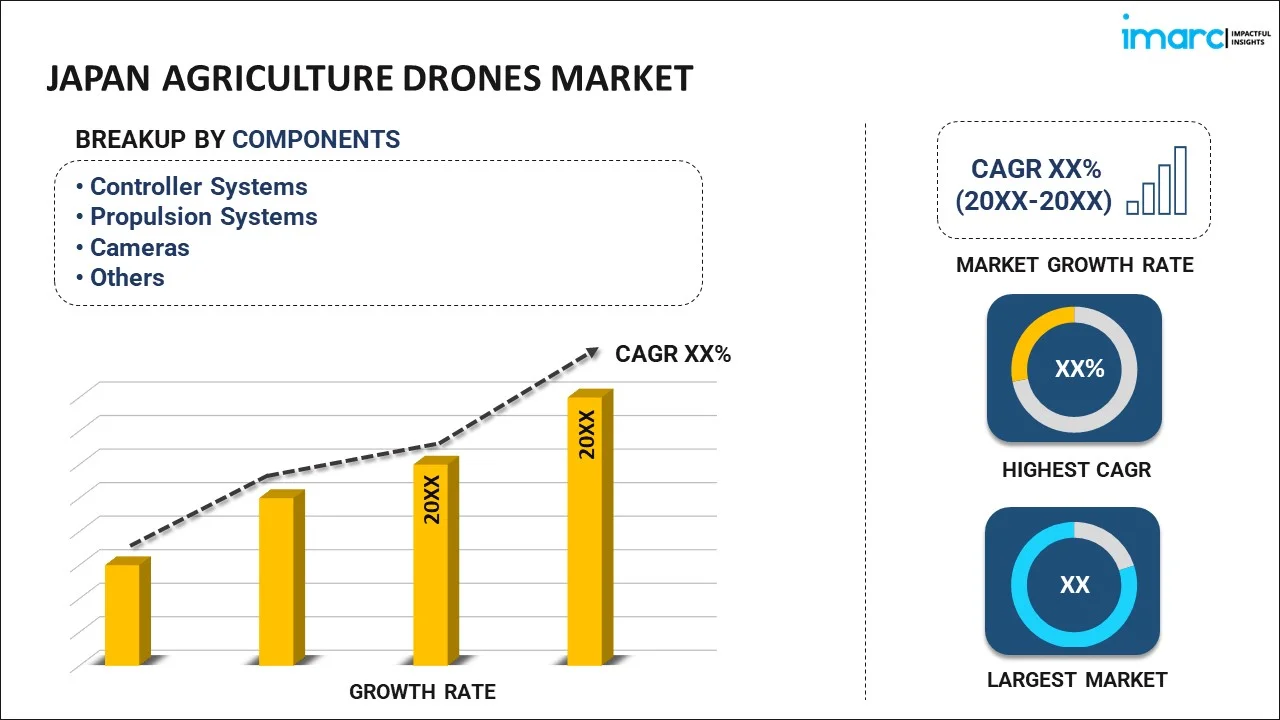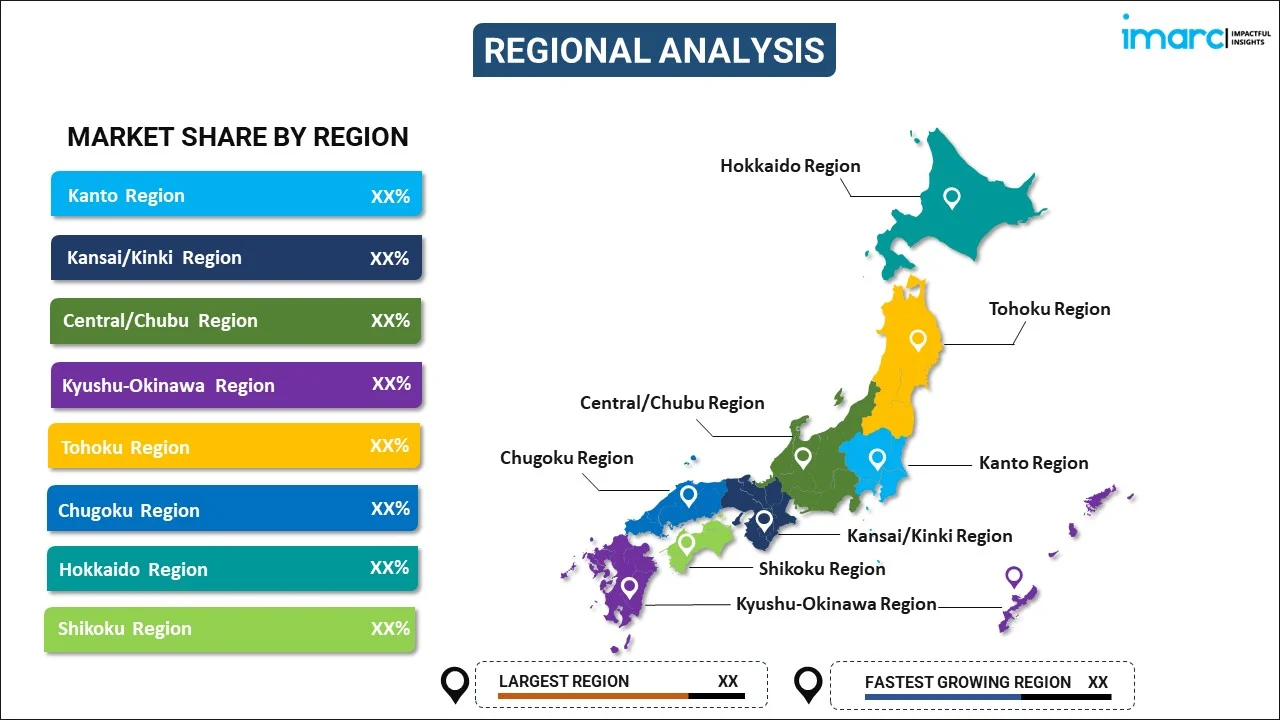
Japan Agriculture Drones Market Report by Component (Controller Systems, Propulsion Systems, Cameras, Batteries, Navigation Systems, and Others), Offering (Hardware, Software), Farming Environment (Indoor, Outdoor), Application (Field Mapping, Variable Rate Application, Crop Scouting, and Others), and Region 2025-2033
Market Overview:
Japan agriculture drones market size reached USD 90.8 Million in 2024. Looking forward, IMARC Group expects the market to reach USD 350.7 Million by 2033, exhibiting a growth rate (CAGR) of 15.39% during 2025-2033. The increasing popularity of drones equipped with various sensors, including multispectral and thermal cameras, that can provide valuable insights into crop health by identifying early signs of stress, disease, or nutrient deficiencies, is primarily driving the market.
|
Report Attribute
|
Key Statistics
|
|---|---|
|
Base Year
|
2024
|
|
Forecast Years
|
2025-2033
|
|
Historical Years
|
2019-2024
|
|
Market Size in 2024
|
USD 90.8 Million |
|
Market Forecast in 2033
|
USD 350.7 Million |
| Market Growth Rate 2025-2033 | 15.39% |
Agriculture drones, also known as agricultural UAVs (unmanned aerial vehicles), are sophisticated, remotely piloted aircraft designed for various tasks within the farming industry. These drones have revolutionized agriculture by offering a range of benefits. They can monitor crop health and growth, detect pests and diseases, and assess irrigation needs with high-resolution cameras and sensors. Agriculture drones enhance efficiency by providing real-time data that helps farmers make informed decisions. They allow for precision farming, optimizing resource use such as water and fertilizers while reducing waste. Drones can cover large fields quickly and navigate difficult terrain, making them invaluable for large-scale farming operations. Additionally, they improve safety by reducing the need for farmers to enter potentially hazardous areas. By aiding in data collection and analysis, agriculture drones contribute to increased yields and improved crop quality. Their ability to collect data efficiently makes them a vital tool in modern agriculture, helping farmers make sustainable and economically viable choices for their operations.
Japan Agriculture Drones Market Trends:
The agriculture drones market in Japan is experiencing robust growth due to several key drivers. Firstly, technological advancements have played a pivotal role in catapulting the adoption of drones in agriculture. With the integration of cutting-edge sensors, AI algorithms, and improved battery life, drones can now provide farmers with highly accurate data on crop health, soil conditions, and irrigation needs. Consequently, this has led to increased productivity and optimized resource utilization. Moreover, the growing regional population and the subsequent need for enhanced food production have compelled farmers to seek innovative solutions. Agriculture drones offer a means to monitor large-scale farms efficiently, enabling precision agriculture practices that boost crop yields and reduce waste. Furthermore, climate change and its unpredictable impact on weather patterns have made it imperative for farmers to adapt swiftly. Drones provide real-time monitoring capabilities, helping farmers respond promptly to changing conditions, minimize losses, and maximize returns. Additionally, numerous supportive policies and incentives offered by governments and regulatory bodies to improve food security and sustainability are expected to drive the agriculture drones market in Japan during the forecast period.
Japan Agriculture Drones Market Segmentation:
IMARC Group provides an analysis of the key trends in each segment of the market, along with forecasts at the country level for 2025-2033. Our report has categorized the market based on component, offering, farming environment, and application.
Component Insights:

- Controller Systems
- Propulsion Systems
- Cameras
- Batteries
- Navigation Systems
- Others
The report has provided a detailed breakup and analysis of the market based on the component. This includes controller systems, propulsion systems, cameras, batteries, navigation systems, and others.
Offering Insights:
- Hardware
- Fixed Wing
- Rotary Wing
- Hybrid Wing
- Software
- Data Management Software
- Imaging Software
- Data Analytics Software
- Others
A detailed breakup and analysis of the market based on the offering have also been provided in the report. This includes hardware (fixed wing, rotary wing, and hybrid wing) and software (data management software, imaging software, data analytics software, and others).
Farming Environment Insights:
- Indoor
- Outdoor
The report has provided a detailed breakup and analysis of the market based on the farming environment. This includes indoor and outdoor.
Application Insights:
- Field Mapping
- Variable Rate Application
- Crop Scouting
- Others
A detailed breakup and analysis of the market based on the application have also been provided in the report. This includes field mapping, variable rate application, crop scouting, and others.
Regional Insights:

- Kanto Region
- Kansai/Kinki Region
- Central/ Chubu Region
- Kyushu-Okinawa Region
- Tohoku Region
- Chugoku Region
- Hokkaido Region
- Shikoku Region
The report has also provided a comprehensive analysis of all the major regional markets, which include Kanto Region, Kansai/Kinki Region, Central/ Chubu Region, Kyushu-Okinawa Region, Tohoku Region, Chugoku Region, Hokkaido Region, and Shikoku Region.
Competitive Landscape:
The market research report has also provided a comprehensive analysis of the competitive landscape. Competitive analysis such as market structure, key player positioning, top winning strategies, competitive dashboard, and company evaluation quadrant has been covered in the report. Also, detailed profiles of all major companies have been provided.
Japan Agriculture Drones Market Report Coverage:
| Report Features | Details |
|---|---|
| Base Year of the Analysis | 2024 |
| Historical Period | 2019-2024 |
| Forecast Period | 2025-2033 |
| Units | Million USD |
| Scope of the Report | Exploration of Historical and Forecast Trends, Industry Catalysts and Challenges, Segment-Wise Historical and Predictive Market Assessment:
|
| Components Covered | Controller Systems, Propulsion Systems, Cameras, Batteries, Navigation Systems, Others |
| Offerings Covered |
|
| Farming Environments Covered | Indoor, Outdoor |
| Applications Covered | Field Mapping, Variable Rate Application, Crop Scouting, Others |
| Regions Covered | Kanto Region, Kansai/Kinki Region, Central/ Chubu Region, Kyushu-Okinawa Region, Tohoku Region, Chugoku Region, Hokkaido Region, Shikoku Region |
| Customization Scope | 10% Free Customization |
| Post-Sale Analyst Support | 10-12 Weeks |
| Delivery Format | PDF and Excel through Email (We can also provide the editable version of the report in PPT/Word format on special request) |
Key Questions Answered in This Report:
- How has the Japan agriculture drones market performed so far and how will it perform in the coming years?
- What has been the impact of COVID-19 on the Japan agriculture drones market?
- What is the breakup of the Japan agriculture drones market on the basis of component?
- What is the breakup of the Japan agriculture drones market on the basis of offering?
- What is the breakup of the Japan agriculture drones market on the basis of farming environment?
- What is the breakup of the Japan agriculture drones market on the basis of application?
- What are the various stages in the value chain of the Japan agriculture drones market?
- What are the key driving factors and challenges in the Japan agriculture drones?
- What is the structure of the Japan agriculture drones market and who are the key players?
- What is the degree of competition in the Japan agriculture drones market?
Key Benefits for Stakeholders:
- IMARC’s industry report offers a comprehensive quantitative analysis of various market segments, historical and current market trends, market forecasts, and dynamics of the Japan agriculture drones market from 2019-2033.
- The research report provides the latest information on the market drivers, challenges, and opportunities in the Japan agriculture drones market.
- Porter's five forces analysis assist stakeholders in assessing the impact of new entrants, competitive rivalry, supplier power, buyer power, and the threat of substitution. It helps stakeholders to analyze the level of competition within the Japan agriculture drones industry and its attractiveness.
- Competitive landscape allows stakeholders to understand their competitive environment and provides an insight into the current positions of key players in the market.
Need more help?
- Speak to our experienced analysts for insights on the current market scenarios.
- Include additional segments and countries to customize the report as per your requirement.
- Gain an unparalleled competitive advantage in your domain by understanding how to utilize the report and positively impacting your operations and revenue.
- For further assistance, please connect with our analysts.
 Inquire Before Buying
Inquire Before Buying
 Speak to an Analyst
Speak to an Analyst
 Request Brochure
Request Brochure
 Request Customization
Request Customization




.webp)




.webp)












